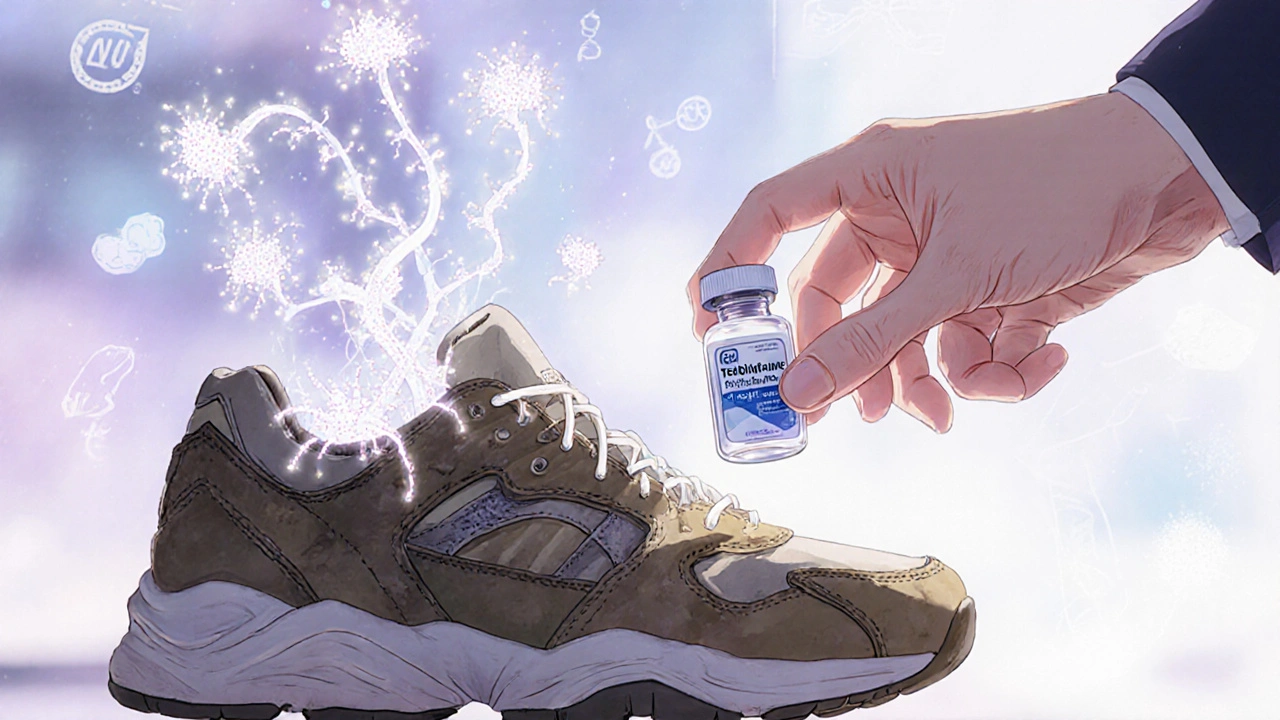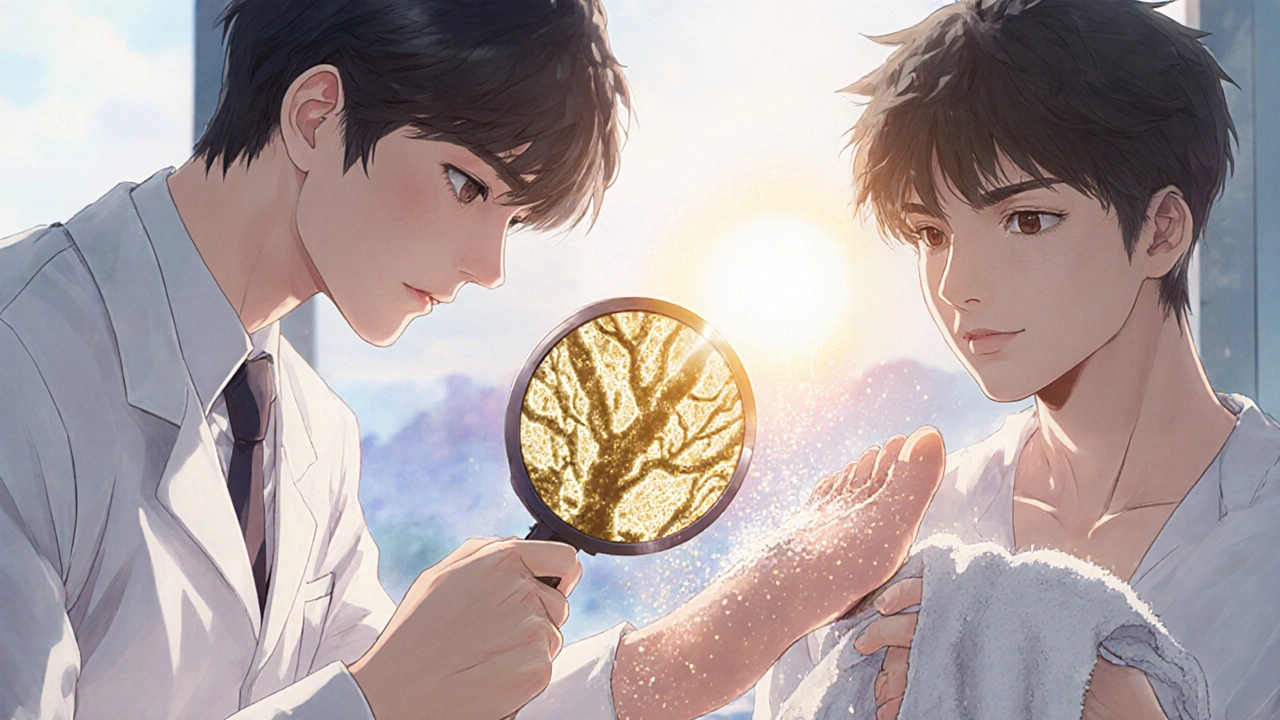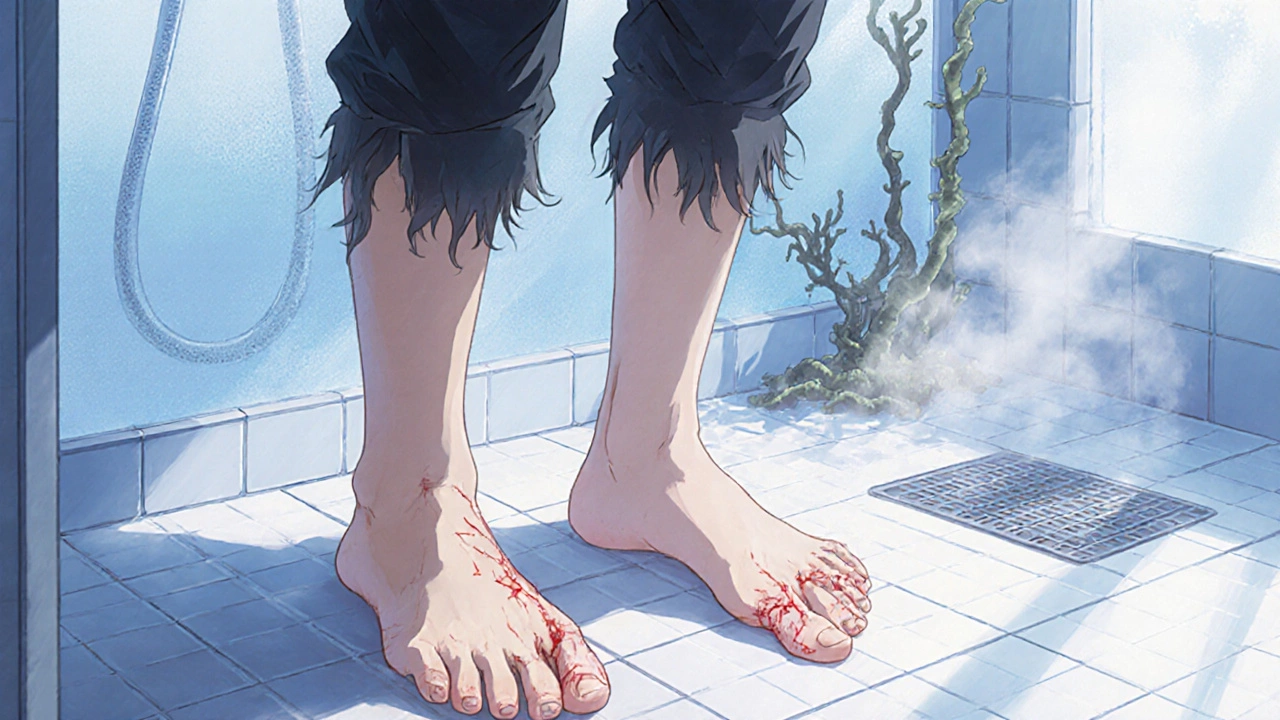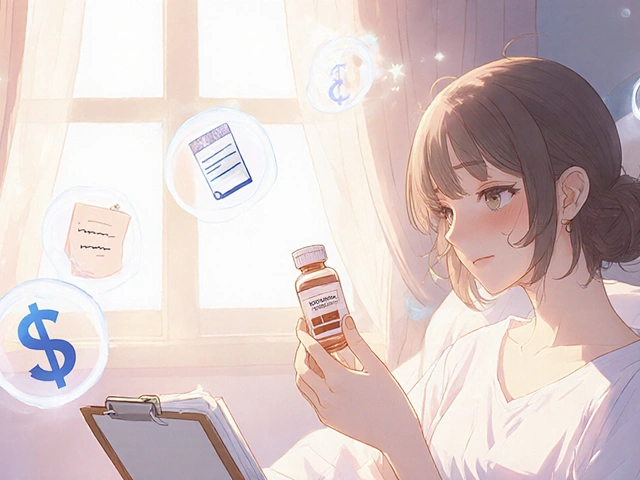More than 1 in 7 people worldwide have a fungal infection right now. It’s not rare. It’s not exotic. It’s athlete’s foot, it’s candida, and it’s showing up in places you’d never expect - between your toes, under your nails, or even in your mouth. And most of the time, people treat it wrong.
You scratch an itchy foot, slap on some cream for a few days, and when the itch fades, you stop. Big mistake. Fungi don’t vanish just because symptoms disappear. They hide. They wait. And they come back - often worse.
What’s Actually Causing Your Itch?
Not all fungal infections are the same. Two of the most common types - athlete’s foot and candida - are caused by completely different organisms, behave differently, and need different treatments.
Athlete’s foot, or tinea pedis, is caused by dermatophytes. These are fungi that live on keratin - the tough protein in your skin, hair, and nails. That’s why they love your feet. Your shoes create the perfect storm: warm, dark, and sweaty. The fungus feeds on dead skin cells and spreads easily in locker rooms, public showers, and even your own bathroom floor. Three main types show up: the interdigital type (between your toes), the moccasin type (dry, flaky skin on the soles), and the blistering type (small fluid-filled bumps).
Candida, on the other hand, is a yeast. The most common culprit is Candida albicans. Unlike dermatophytes, it doesn’t need keratin to survive. It thrives in moist, warm areas with lots of sugars - think vaginal folds, under the breasts, inside the mouth (oral thrush), or even the bloodstream in people with weakened immune systems. While athlete’s foot is mostly a nuisance, candida can turn serious fast. In people with diabetes or HIV, invasive candidiasis can be deadly. The CDC estimates about 46,000 cases of invasive candidiasis happen in the U.S. each year.
How Do You Know Which One You Have?
It’s easy to mix them up. Both cause itching, redness, and flaking. But here’s how to tell the difference:
- Athlete’s foot: Starts between the toes. Skin peels, cracks, or gets soggy. Often smells a little sour. Spreads to the soles or sides of feet. Rarely affects nails unless it’s been going on for months.
- Candida infection: Bright red, shiny patches. May have white patches (like thrush in the mouth). Itching is intense, sometimes burning. In women, vaginal yeast infections come with thick, white discharge and swelling. In men, it’s often a red rash on the penis.
If you’re unsure, don’t guess. A doctor can scrape a bit of skin or nail and look at it under a microscope. That’s the only way to be sure.
Topical Treatments: What Works, What Doesn’t
Most people start with over-the-counter creams. And most of them fail - not because the medicine doesn’t work, but because they use it wrong.
Here’s what actually works:
- Terbinafine (Lamisil): The gold standard for athlete’s foot. Kills the fungus, doesn’t just slow it down. Works in 1-2 weeks for most cases. Studies show 70-90% cure rates when used correctly.
- Clotrimazole or miconazole: Common in drugstore brands. Good for mild cases. But they only stop the fungus from growing - they don’t kill it. That’s why recurrence is so high.
- Whitfield’s ointment: A mix of salicylic acid and benzoic acid. It doesn’t kill the fungus directly. Instead, it peels away the infected skin layer. Works best for the peeling, cracked type of athlete’s foot. Cure rate around 65% in 4 weeks.
Here’s the mistake most people make: They stop when it stops itching. That’s usually after 3-5 days. But the fungus is still alive under the surface. The CDC and Cleveland Clinic both say: Keep using the cream for at least 1-2 weeks after symptoms vanish. Otherwise, you’re setting yourself up for a comeback.
And don’t forget the powder. Antifungal powders with miconazole or tolnaftate help keep feet dry. Moisture is the enemy. Even after the infection clears, using powder daily for a month reduces recurrence by nearly half.

Oral Medications: When You Need More Than Cream
If your athlete’s foot has spread to your nails, or if you’ve tried everything and it keeps coming back, you need oral meds.
- Terbinafine (250 mg daily): Taken for 2-6 weeks. 80% cure rate for nail infections. Side effects? Rare, but liver checks are recommended if you’re on it longer than 6 weeks.
- Itraconazole (200 mg daily): Works well for stubborn cases. Often used in pulse dosing - one week on, three weeks off - to reduce side effects.
- Fluconazole (150 mg weekly): The go-to for candida infections. Used for vaginal yeast infections, oral thrush, or skin candidiasis. Usually takes 1-2 weeks.
Oral antifungals cut recurrence rates from 40% down to 15-20%. That’s a big difference. But they’re not for everyone. If you have liver disease, heart problems, or take blood thinners, talk to your doctor first.
Why Do These Infections Keep Coming Back?
Recurrence isn’t bad luck. It’s a pattern.
On Reddit, users like ‘FootFungusFighter’ say terbinafine cleared their 6-month infection in 10 days - after clotrimazole failed for weeks. But others, like ‘SoleSurvivor’ on Drugs.com, stopped treatment early. The itch went away, so they thought it was gone. Two weeks later? Worse than before.
Studies show 67% of people who finish their full treatment get rid of it. Only 32% who quit early do. That’s not a coincidence.
Other reasons it comes back:
- Wearing the same socks or shoes without cleaning them
- Walking barefoot in damp areas
- Not drying between toes after showers
- Using someone else’s towel or shower mat
And here’s something most people don’t know: The fungus can live in your shoes for months. If you don’t treat your footwear, you’re re-infecting yourself every time you slip them on. Spray them with antifungal spray or toss them. Seriously.
What’s New in Antifungal Treatment?
Medicine isn’t standing still. In 2021, the FDA approved ibrexafungerp - the first new class of antifungal drug in 20 years - for stubborn vaginal yeast infections. It works differently than older drugs, making it effective against resistant strains.
And in early 2023, a new topical drug called olorofim showed 82% success in clearing stubborn athlete’s foot cases that didn’t respond to anything else. It’s still in trials, but it’s a sign that we’re finally catching up to fungi that are learning to resist old treatments.
Meanwhile, the CDC’s ‘My Action Plan’ program - rolled out in 2022 - has helped diabetes clinics cut recurrent fungal infections by 35% by teaching patients how to check their feet daily and keep them dry.
But here’s the scary part: A new super-fungus called Trichophyton indotineae, first spotted in India in 2017, is now in 28 countries. It’s resistant to terbinafine. Doctors are seeing cases where nothing works. The WHO lists it as a priority pathogen. This isn’t science fiction. It’s happening now.

How to Prevent It for Good
Prevention isn’t about being perfect. It’s about being consistent.
- Dry your feet thoroughly after showers - especially between the toes. Use a separate towel.
- Wear moisture-wicking socks. Cotton holds sweat. Synthetic blends dry faster.
- Change socks daily. If your feet sweat a lot, change them twice a day.
- Never walk barefoot in public showers, pools, or gyms. Flip-flops cost less than a new pair of shoes after a fungal infection.
- Use antifungal powder in shoes and socks if you’re prone to it.
- Don’t share towels, shoes, or nail clippers.
- Wash your feet daily with soap and water. Don’t just rinse.
And if you have diabetes? Check your feet every day. Fungal infections can turn into ulcers, then infections, then amputations. It’s not a myth. It’s a documented risk.
When to See a Doctor
You don’t need to run to the clinic for a mild itch. But if any of these happen, get help:
- The redness spreads beyond your feet
- You see pus, swelling, or fever
- It’s been 4 weeks and nothing’s changed
- You have diabetes, HIV, or take immunosuppressants
- The infection keeps coming back
Untreated athlete’s foot can lead to cellulitis - a bacterial skin infection that can land you in the hospital. Candida in the bloodstream can kill. These aren’t just rashes. They’re infections. And infections don’t heal themselves.
Can athlete’s foot go away on its own?
No. While symptoms might fade temporarily, the fungus remains active. Without treatment, it spreads to other parts of your body - like your nails, groin, or hands. The CDC and Cleveland Clinic both state that athlete’s foot doesn’t resolve without intervention.
Is candida the same as a yeast infection?
Yes. Candida is a type of yeast. When people say "yeast infection," they usually mean a Candida albicans overgrowth. This can happen in the vagina, mouth, skin folds, or bloodstream. Not all yeast infections are Candida, but 90% of them are.
Can I use antifungal cream on my face?
Generally, no. Facial skin is more sensitive. Antifungal creams designed for feet or nails can cause irritation, redness, or peeling on the face. If you have a fungal rash on your face - like seborrheic dermatitis or tinea faciei - see a doctor. They’ll prescribe a milder, face-safe antifungal.
Why does my athlete’s foot keep coming back even after treatment?
The most common reason is incomplete treatment. Stopping too early is the #1 mistake. Other causes: re-exposure to contaminated shoes, socks, or floors; not drying feet properly; or having an underlying condition like diabetes that weakens your body’s ability to fight fungi. In rare cases, a resistant strain like Trichophyton indotineae may be the cause.
Are natural remedies like tea tree oil effective?
Some studies show tea tree oil has mild antifungal properties, but it’s not reliable enough to treat active infections. It might help as a supplement for prevention or very mild cases. But if you have symptoms, stick with proven antifungals like terbinafine or clotrimazole. Don’t risk letting it spread.
Can fungal infections spread to other people?
Yes, but not as easily as people think. Athlete’s foot spreads through direct contact with infected skin or contaminated surfaces - like shower floors, towels, or shoes. Candida isn’t typically contagious between healthy adults. But in hospitals or among immunocompromised people, it can spread. Practice good hygiene: don’t share personal items, wash hands after touching infected areas.
What Happens If You Ignore It?
Ignoring a fungal infection doesn’t make it go away. It makes it worse.
Athlete’s foot can spread to your toenails, turning them thick, yellow, and crumbly. That’s onychomycosis - and it’s much harder to treat than skin fungus. It can also lead to bacterial infections like cellulitis, especially in people with diabetes. In extreme cases, it can even reach the bone.
Candida, if left unchecked in someone with a weak immune system, can enter the bloodstream and cause sepsis. That’s life-threatening. Even in healthy people, chronic candida overgrowth can cause fatigue, brain fog, and recurring digestive issues.
Fungi aren’t just annoying. They’re persistent. And they’re adapting. The global antifungal market is growing fast - not because more people are getting infected, but because the ones we have are harder to kill.
The good news? You don’t need to live with it. With the right treatment, proper hygiene, and patience, you can beat it. For good.







Noel Molina Mattinez
November 17, 2025 AT 10:12Stop using that cream after 3 days you idiot. I did that and my toenail fell off. Just keep it on till the skin grows back. No excuses.
Roberta Colombin
November 18, 2025 AT 03:29Thank you for writing this so clearly. Many people don’t realize how serious fungal infections can be, especially with diabetes. Keeping feet dry and changing socks daily is simple but so important. I’ve shared this with my book club - we’re all older and appreciate clear advice.
Dave Feland
November 18, 2025 AT 12:03Let’s be precise: the claim that "fungal infections are not rare" is statistically misleading. The CDC reports prevalence rates vary significantly by region, age, and comorbidities. Furthermore, the assertion that terbinafine has a "70-90% cure rate" is cherry-picked from randomized trials with strict inclusion criteria - real-world adherence drops efficacy to ~52%. And don’t get me started on the pseudoscientific promotion of "antifungal powders" as preventative magic. The microbiome is not a battlefield. It’s an ecosystem.
Ashley Unknown
November 18, 2025 AT 15:02Okay but have you heard about the secret government program that’s been spraying antifungal agents in public showers since 2019 to control the population? I read it on a forum where a guy claimed his cousin works at the CDC and said they’re using it to make people dependent on meds. That’s why they push terbinafine so hard - it’s not about healing, it’s about profit. And don’t even get me started on how your shoes are probably bugged with tracking chips embedded in the foam. I threw mine out and now I walk barefoot in the woods. My skin cleared up in 4 days. Coincidence? I think not.
Georgia Green
November 19, 2025 AT 21:43Thanks for this! I had athlete’s foot for years and kept stopping the cream too early. Started using terbinafine for 2 weeks after the itch was gone and it finally worked. Only thing I forgot was the powder - my feet got sweaty again and it came back. Lesson learned. Also, tea tree oil didn’t do squat for me.
Christina Abellar
November 21, 2025 AT 11:36Good info. I just started using antifungal powder daily after showers. Small change, big difference.
Eva Vega
November 21, 2025 AT 19:58The pathophysiology of dermatophyte colonization hinges on keratinolytic enzyme expression and biofilm formation within the stratum corneum. Topical azoles exhibit fungistatic activity, whereas allylamines like terbinafine demonstrate fungicidal properties via squalene epoxidase inhibition. Compliance beyond symptom resolution remains the primary determinant of recurrence risk, with adherence below 14 days correlating with 67% relapse in prospective cohorts.
Matt Wells
November 22, 2025 AT 11:21It is regrettable that the author conflates anecdotal Reddit testimonials with clinical evidence. The cited cure rates derive from double-blind, placebo-controlled trials - not user-submitted forum narratives. Furthermore, the casual reference to "super-fungus" is sensationalist and undermines scientific literacy. Trichophyton indotineae is a documented clinical entity, yes, but its global spread remains confined to specific geographic foci. The alarmist tone is unbecoming of medical discourse.
George Gaitara
November 23, 2025 AT 15:16Yeah right. Like I’m supposed to believe that a cream is going to kill something that’s been living on my feet for years. I’ve tried everything. The real problem? The government doesn’t want you to know that fungi are actually sentient and they’re retaliating because we’ve been poisoning the planet. That’s why they push these drugs - to keep you docile. I’ve been living on garlic and vinegar for six months. My feet are fine. The doctors are lying.